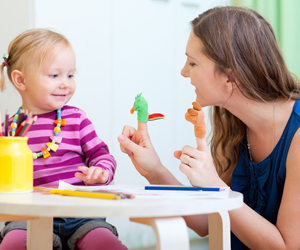

Clinic For Speech Therapy &
Occupational Therapy
Speech and Language Therapy:
The SLP interacts with a child by playing and talking, using pictures, books, objects, or ongoing events to stimulate language development. The therapist may interact with a child one-on-one, in a small group or directly in a classroom to overcome difficulties involved with a specific disorder. And also the SLP may model correct vocabulary and grammar and use repetition exercises to build language skills.
Once an initial assessment is performed, the SLP will determine the best course of action. Interventions vary depending on what communication or feeding and swallowing goals will be targeted. Therefore based on each and every individual the goal program may vary and it may include different components of speech and language. When the SLP begins to work with the child his overall communication may improve as the goal program is focused on in improving his overall communication skills.
An SLP strives to make every therapy session feel like play, especially for the youngest children. To improve speech and language, SLP might have a child play with a baby doll and pretends to feed it, naming and talking about pre-selected or strategically selected food to improve production of certain sounds.

Playing with the doll and practicing targeted sounds is fun and therapeutic for children at the same time. To target a child’s receptive language and/or executive functioning goals, a therapist may create a fun, motivating obstacle course where the child needs to follow specific directions and recall a sequence of events.
Likewise speech and language therapy will mainly focus on improving the child’s communicative abilities in a holistic manner. For example once the child is exposed to speech and language therapy he may politely request for his needs, she may start naming the objects around her, he may actively follow commands that you ask him to follow, she may sing a rhyme with cutest expressions and words, he may shout out loud how a train goes, she may begin to realize the function of each and every object that she uses in her day to day life, he may categorize objects or pictures when many are given together, she may start answering questions and also questioning others, he may show interest in different types of play activities and so on.
An SLP gives parents and children the tools they need to improve their language skills, but therapist says "It’s the time spent using those tools at home and in the children’s natural environment that really creates lasting change". Practicing what is learned at the therapy appointments is just as important as the appointments themselves. Parents should ask the therapist what goals and strategies can be carried over into the home environment to improve speech and language skills.